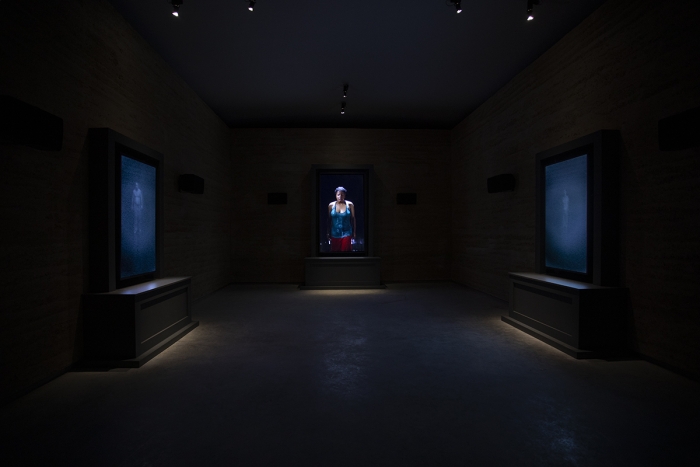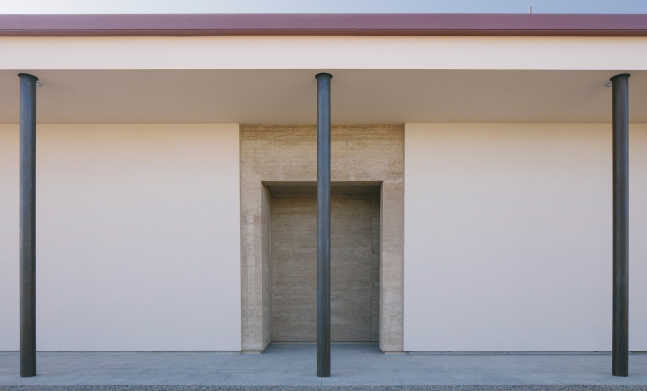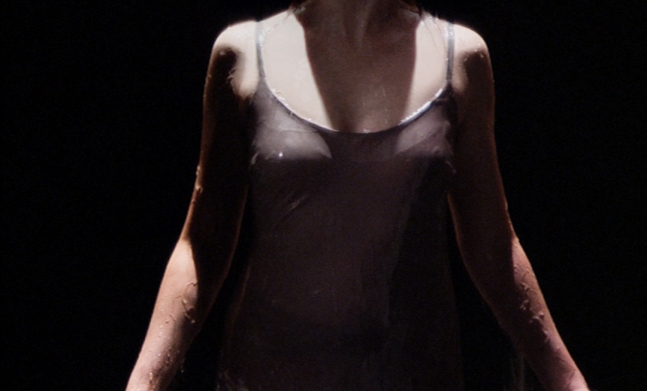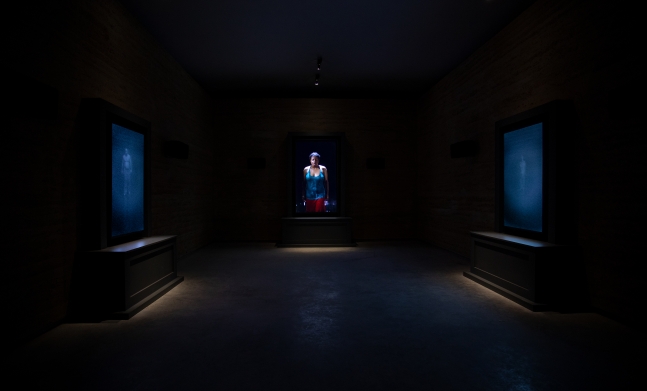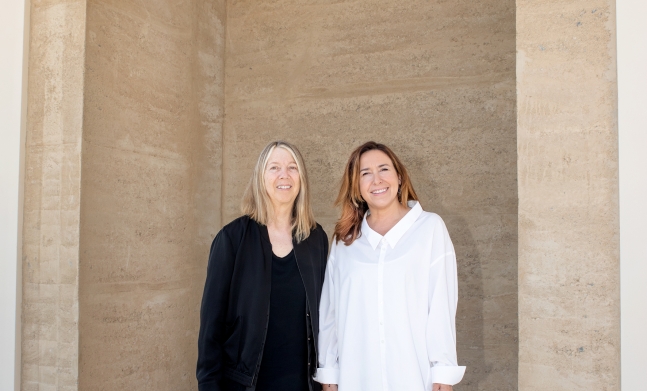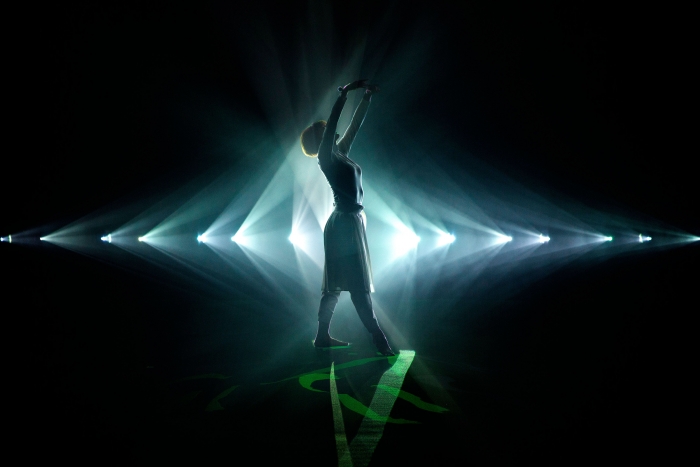This piece from the internationally renowned pioneer in video art lands in Spain for the first time and has been installed definitively in PLANTA, making it the first permanent installation of this innovative project from Sorigué.
The work, composed of three high-definition vertical screens, represents a series of encounters on the threshold between life and death. It was created to be exhibited in the Church of San Gallo during the Venice Biennale in 2007, and since that date it has not been re-exhibited in Europe.
Ocean Without a Shore will be open to the public next autumn. It now joins Double Bind, by Juan Muñoz, an installation on display when PLANTA opened its doors to the general public two years ago.
The work is installed inside a completely renovated building. The interior space that houses the installation has been built with materials from the Sorigué gravel pit, with an innovative system based on the circular economy.
After its successful debut in Madrid, Fundació Sorigué is also bringing a selection of the works exhibited in the Mat Collishaw exhibit to its museum in Lleida for the second semester. Dialogues, presented at the Royal Botanical Garden in April and May of this year.
Lleida, 6 June –PLANTA, the innovative project promoted by the Sorigué group and the Fundació Sorigué, inaugurates its first permanent installation with the work Ocean Without a Shore by the internationally recognised pioneer in video art, Bill Viola. The work can be visited by the general public from this autumn.
Ocean Without a Shore is a cyclical progression of images representing a series of encounters on the threshold between life and death. The work is composed of three high-definition vertical screens inserted in altars and a sound installation. The work was created to be exhibited in the 15th-century Italian Church of San Gallo as a collatoral project during the Venice Biennale in 2007, and since that date it has not been re-exhibited in Europe.
Commenting on his work, the artist said: “Ocean Without a Shore deals with the presence of the dead in our lives. In a dark room, the three altars on which the screens are placed become portals for the passage of the dead to and from our world”.
To recreate the work, a specific room has been built to accommodate it. This structure is the result of a research project developed between Sorigué and the Fet de Terra architecture study, under criteria of sustainability, innovation, and circular economy.
The construction system used the earth from Sorigué’s gravel pit to create the walls and, for the first time, a flat roof made of reinforced compacted earth. This innovative project guarantees a sustainable building in terms of the environment and promotes the circular economy within the company.
This particular space is installed in a completely rehabilitated building that was previously a place of work in Sorigué’s active industrial complex in Balaguer (Lleida), thus becoming the first permanent installation from the PLANTA project, a space of confluence and interaction for contemporary artistic creation and business innovation of the Sorigué Group and its foundation. The innovative concept opened its doors to the public in 2017 with the monumental Double Bind installationby Juan Muñoz, which was loaned to PLANTA for five years by the artist’s estate.
Ana Vallés, President of Sorigué and Director of the Fundació Sorigué, notes that the installation of Ocean Without a Shore “is a visible manifestation of everything that PLANTA represents, as well as the values of Sorigué, since it involves the restoration of an existing building, using materials from our own gravel pit, through an innovative construction process based on very traditional materials. It is a comprehensive exercise of innovation, sustainability and the circular economy”.
ABOUT OCEAN WITHOUT A SHORE
Presented as a series of encounters occurring on the threshold between life and death, the sequence of videos displayed on the three screens comprising Ocean Without a Shore (2007) documents a succession of people who emerge slowly from the darkness and approach the light. Each person must then traverse an invisible threshold of water and light to pass into the physical world. However, once they take on a body, all beings realise that their presence is finite and therefore must separate themselves from the material existence to return whence they came. The cycle repeats endlessly.
The work is a high definition colour video triptych composed of three flat screens mounted vertically and accompanied by a sound installation. Ocean Without a Shore is projected continuously and features the participation of 24 people.
According to Kira Perov, executive director of the Bill Viola Studio and the artist’s wife, this work generates a very emotional experience in spectators who, standing in a dark room, perceive the people on the screens “as walking through the wall and into space, as if they were among us. The loud sound of the sprays of water as they pass through adds to this perception.”
Ana Vallés remembers that the Fundació Sorigué contemporary art collection “is built with a humanist outlook, putting the focus on human being, his concerns and the major universal issues. Along these lines, Ocean Without a Shore is one of the clearest exponents of this outlook, being a key component of the collection both in itself, and through the relationships that it creates with other works in the collection”.
Bill Viola commented that for this creation he took inspiration from a poem by the 20th century Sengalese poet and narrator, Birago Diop who wrote: “The dead are never gone…”.
The artist’s initial idea was to place an edition of this work on different continents. Ocean Without a Shore was exhibited from 2008 for two yearsat the National Gallery of Victoria in Melbourne, Australia, where it is part of their collection. Another edition was acquired by the SBS (Seoul Broadcasting System) Prism Tower Art Collection, Seoul, South Korea; and another, by the Pennsylvania Academy of the Fine Arts (PAFA), Philadelphia, USA, in 2011. This month the work will be reinstalled and on view indefinitely in as part of an exhibition on the artist in three of this city’s institutions.
With its permanent installation in PLANTA, Ocean Without a Shore will now return to Europe.
ABOUT OCEAN WITHOUT A SHORE IN PLANTA
The three screens that were planned for this work fit almost perfectly in the stone altars that were in the original work site, the Church of San Gallo in Venice. This is why, in its permanent location in Spain, in PLANTA, the dimensions of the three altars have been recreated as well as the dimensions of the room, seeking to rebuild a similar introspective environment.
The room where the work is located, which has been specially created to house it, is the result of a research project carried out under the criteria of sustainability, innovation and circular economy. The structure, developed by the architectural studio Fet de Terraand built by the business group’s construction branch, has been made using a raw earth firing system. This millennial technique was recovered to create a healthy space which regulates humidity and indoor temperature, absorbing electromagnetic and acoustic waves from outside. To make this “earth box”, a by-product known as raw earth has been used. This is left over once the aggregates have been separated and filtered, in this case, aggregates from Sorigué’s La Plana del Corb gravel pit.
Developed with the support of the Sorigué research laboratory, also located in PLANTA, five formulations of soil have been used in the final product. These have obtained the necessary structural resistance to create this 65 m2 room, with 4.5 m tall and 45 cm wide walls, and, for the first time, a flat roof of compacted reinforced earth.
This project guarantees a sustainable building for the environment, an architecture born and rooted in the land itself and integrated into the existing landscape. It also promotes the circular economy within the company through circularity in materials, methods and technology.
The room that houses Bill Viola’s work is in turn located in a completely renovated building that for decades functioned as a workspace for the Sorigué industrial complex.
ABOUT BILL VIOLA
Bill Viola is internationally recognized as one of the leading artists of our time, an acknowledged pioneer in the medium of video art. For over 40 years he has been making work that explores a series of humanistic and spiritual issues. His works include room-size video installations, sound environments, electronic music performances and flat panel video pieces, as well as works for television broadcast, concerts, opera, and sacred spaces.
Viola’s video installations – total environments that envelop the viewer in image and sound – employ state-of-the-art technologies and are distinguished by their precision and direct simplicity. They are shown in museums and galleries worldwide and are found in many distinguished collections. His single-channel videotapes have been widely broadcast and presented cinematically, while his writings have been extensively published and translated for international readers.
Bill Viola was born in New York in 1951 and graduated from Syracuse University in 1973. He represented the US at the Venice Biennale in 1995. Other key solo exhibitions include; Bill Viola: A 25-Year Survey organized by the Whitney Museum of American Art (1997); The Passions at the J.Paul Getty Museum (2003); Hatsu-Yume (First Dream) at the Mori Art Museum in Tokyo (2006); Bill Viola, visioni interiori at the Palazzo delle Esposizioni, (2008); Bill Viola, Grand Palais, Paris (2014); and in 2017, four major exhibitions: Bill Viola. Electronic Renaissance, Palazzo Strozzi, Florence; Bill Viola: Installations, Deichtorhallen, Hamburg; Bill Viola: Retrospective, Guggenheim Bilbao, Spain; Bill Viola: Selected Work 1977–2014, Redtory Museum of Contemporary Art, Guangzhou, China; and Bill Viola/Michelangelo, Royal Academy of Arts, London, 2019. Martyrs (Earth, Air, Fire, Water), the first of two permanent works created for St Paul’s Cathedral, London, was inaugurated in 2014, followed by Mary in 2016.
Viola is the recipient of numerous awards and honors including a John D. and Catherine T. MacArthur Foundation Fellowship (1989). In 2006 he was awarded Commander of the Order of Arts and Letters by the French Government. In 2009 he received the XXI Catalonia International Prize in Barcelona, Spain and was awarded the Japan Art Association’s Praemium Imperiale art award in the category of painting in 2011. Viola was elected an Honorary Royal Academician in 2017.
Kira Perov is Executive Director of Bill Viola Studio. She has worked closely with Bill Viola since 1979, managing, creatively guiding and assisting with the production of his video works and installations. She edits all Bill Viola publications and organizes and coordinates exhibitions of the work worldwide. Kira Perov earned her BA (Honors) in languages and literature from Melbourne University, Australia in 1973.
ABOUT PLANTA
PLANTA is an innovative business management project based in Sorigué’s industrial complex in Balaguer (Lleida, Spain). This location is home to art, architecture, knowledge and a landscape that is both natural and industrial, creating an environment where industrial processes, research into new materials and site-specific installations from contemporary artists drive creativity and talent.
PLANTA opened its doors to the public for the first time with Double Bindby Juan Muñoz. This monumental installation, considered to be the pinnacle work of this internationally renowned artist, was created in 2001 for the Turbine Hall in the Tate Modern. PLANTA has developed a unique space for this piece, located in an old keystone production site made from large-scale prefabricated concrete.
With the inauguration of Bill Viola’s installation, PLANTA begins the opening of a site-specific series that will be released in the coming months with the work of great artists such as William Kentridge, Chiharu Shiota and Anselm Kiefer, among others.
For its part, the Fundació Sorigué has been promoting social, educational and cultural activities for more than 25 years, especially in those territories where the business group is present. The Foundation has one of the most recognised private collections of contemporary art in Spain and organises temporary exhibitions focused on bringing contemporary artistic creation to all audiences.
Fundació Sorigué promotes the Sorigué business group’s desire to give back. The group supports the circular economy and is a leader in the sectors of construction, urban services—landscaping and waste collection and treatment—, engineering and water and materials science and has been committed to innovation and sustainability since its beginning.
ABOUT THE FUNDACIÓ SORIGUÉ CONTEMPORARY ART COLLECTION
The Fundació Sorigué is particularly famous for having one of the most distinguished private contemporary art collections in Spain. In its headquarters in Lleida, the Fundació Sorigué houses the collection and schedules temporary exhibitions from artists such as Antonio López, Wim Wenders, Chiharu Shiota, and Oscar Muñoz. In April and May 2019, the Fundació Sorigué debuted in Madrid with an exhibition by British artist Mat Collishaw.
The Fundació Sorigué’s contemporary art collection has been awarded the Arte y Mecenazgo prize, promoted by the “la Caixa” foundation, in May 2015; and the GAC Prize for Collecting in 2017, from the Art Galleries Guild of Catalonia with the collaboration of the Barcelona Art Association.
Consisting of more than 450 works by Spanish and international artists, the collection selects its pieces using criteria that are both professional and emotional—rather than specific styles, trends, or artists— always focusing on the most sensitive and human aspects of art. As a result, internationally renowned artists such as Doris Salcedo, William Kentridge, Juan Muñoz, Antonio López and Bill Viola feature alongside lesser known artists to develop an open collection where the interplay between the pieces themselves and between the public and the setting are especially significant.
As well as Ocean Without a Shore, the collection also has Bill Viola’s The Return (2007) and Observance (2002). The Return is a high-definition colour video art made on a 50-inch plasma screen that is part of the sequence of characters that make up Ocean Without a Shore. Observance is also a piece of video art made in high definition on the flat screen.
FREE ADMISSION TO PLANTA
PLANTA can be visited for free under a previous visit. Ocean Without a Shore can be visited from autumn 2019. Bookings via: www.plantaproject.com
